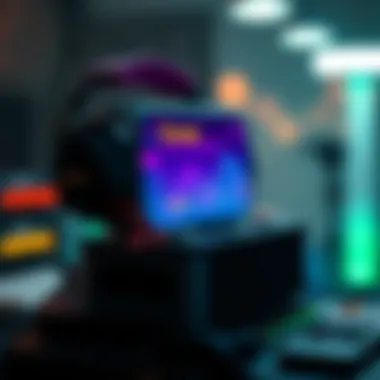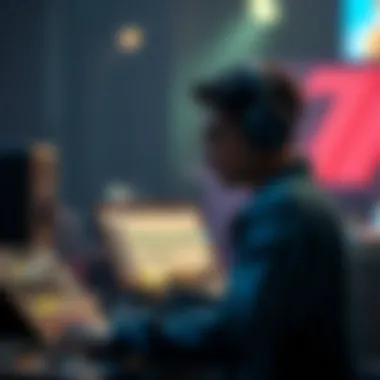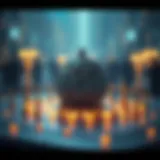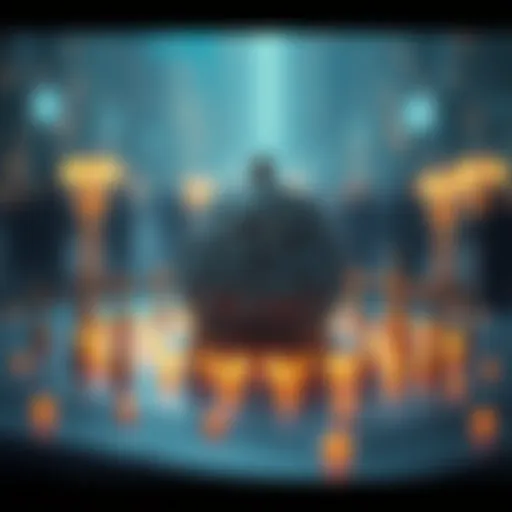The Impact of NFTs on the Music Industry


Intro
The advent of non-fungible tokens (NFTs) has rattled the traditional framework of many industries, music being a major player on this chessboard. Artists and fans are starting to see a world where ownership and engagement come with a digital twist. No longer confined to mere streaming revenues or physical album sales, musicians can now explore a new avenue in which their creations can gain bespoke value through NFTs. This exploration is not merely a passing trend; it constitutes a radical departure from how music has been experienced and monetized.
As we embark on this intricate journey, it’s essential to grasp the building blocks underpinning this major shift. In the age of digital experiences, what does it truly mean to be an owner of a song or an album? How does blockchain technology intermingle with artistic expression? These are the kinds of questions we will seek to address, carving out a better understanding and offering profound insights into the intricate threads weaving together music, art, and the novel world of NFTs.
Understanding Cryptocurrency Basics
What is Cryptocurrency?
Before diving into NFTs, there's a need to delineate what cryptocurrency encapsulates. Simply put, cryptocurrency is a form of digital or virtual currency that employs cryptography for security. Unlike dollar bills or coins gathered in a piggy bank, cryptocurrencies are entirely decentralized—existing solely on the blockchain, a public ledger that records all transactions made using that currency.
In practical terms, you can think about cryptocurrency as a way to trade value over the internet without the need for intermediaries like banks. Bitcoin was the first, but now options abound, including Ethereum, which serves as the vehicle behind many NFTs.
Key Terminology and Concepts
To navigate the nuanced discussion surrounding NFTs and music, it’s wise to familiarize yourself with some relevant terms:
- Blockchain: This is the foundation of all cryptocurrencies. It's a series of blocks containing data that is stored across a network of computers, making it nearly impossible to alter.
- Minting: This is the process of creating a new NFT and making it live on the blockchain.
- Smart Contracts: These are self-executing contracts with the terms of the agreement directly written into code, facilitating and enforcing the transaction automatically.
- Royalty Distribution: A critical feature for artists, it allows creators to earn a percentage from secondary sales of their work.
- Gas Fees: These are transaction fees necessary to process actions on the blockchain, which can vary significantly depending on network congestion.
Understanding these concepts is key to appreciating how NFTs bring a fresh breath to the art of music.
The Trade-off Between Ownership and Accessibility
One of the heart-wrenching dilemmas surfacing from NFT adoption in music lies in balancing the notion of ownership against accessibility. For instance, when an artist decides to release a limited number of NFTs associated with a song, the allure of exclusivity is evident. However, such a strategy can create a wall between the artist and fans who may not be able to afford these unique tokens.
Here, it becomes clear that NFTs have the power to either democratize or polarize the music industry.
"The intersection of technology and creativity is where the magic happens, but it can also murky the waters of equal access."
By weighing both sides of the coin, artists can find ways to engage their larger fan base while also rewarding loyal supporters with unique experiences.
Future Trends to Consider
The landscape of music, bolstered by NFTs, is far from static. Artists are beginning to experiment with dynamic content—such as evolving music tracks tied to collectible artwork—and this is just the tip of the iceberg. As we look towards the future, it’s vital to stay informed about how evolving technologies will continue to shape musicians’ rights and fan experiences.
Intro to NFTs in Music
In today's digital landscape, where streaming services dominate, the emergence of non-fungible tokens (NFTs) marks a pivotal point for the music industry. Understanding how NFTs can impact the music ecosystem is essential for artists, listeners, and industry insiders alike. This section will dive into the core aspects of NFTs within music, showcasing their potential to redefine ownership, empower artists, and foster new fan relationships.
Defining Non-Fungible Tokens
Non-fungible tokens, or NFTs, are digital assets that represent ownership of unique items on the blockchain. Unlike cryptocurrencies such as Bitcoin or Ethereum, which are interchangeable, NFTs are distinct and carry specific information that makes them different from one another. For example, an NFT could embody a piece of artwork, music, or even a video clip, providing verifiable ownership and scarcity.
NFTs utilize smart contracts, which automated self-executing contracts with the terms of the agreement directly written into code. This feature enables artists to stipulate conditions under which their pieces can be sold, resold, or licensed, thereby gaining control over their work's economic benefits.
Benefiting from the unique characteristics of blockchain technology, NFTs promise a new form of ownership and revenue potential for musicians. Artists can sell their creations directly to fans, cutting out intermediaries who have traditionally taken a substantial slice of their earnings. This shift empowers creators, allowing them to engage with their audience in more innovative and lucrative ways.
Brief History of NFTs
The concept of non-fungible tokens is not as recent as one might think. The groundwork for NFTs was laid in the early 2010s with the emergence of blockchain technology. However, it wasn't until 2017 that NFTs entered the limelight, primarily due to the launch of CryptoKitties, a blockchain-based game that allowed users to buy, sell, and breed digital cats.
As the popularity of CryptoKitties soared, it became apparent that NFTs could extend well beyond simple gaming collectibles. This opened the floodgates for various industries, including art, gaming, and now music, to explore how they may leverage NFTs to reshape their models.
By 2020, the NFT marketplace exploded into mainstream consciousness, with music artists and record labels dipping their toes into NFT waters. Big names like Grimes and Steve Aoki began releasing exclusive tracks and visual experiences as NFTs, drawing massive interest and sales. The sales figures were staggering—one piece by digital artist Beeple sold for over $69 million, illustrating the significant value collectors are willing to place on unique digital rights.
As the trend continues to gain momentum, understanding NFTs in music is not merely a passing fascination but a necessary exploration for anyone involved or interested in the future of musical expression and commerce.
"The rise of NFTs in music emphasizes a paradigm shift. They invite artists to embrace their creativity without the longstanding chains of traditional distribution channels."
By harnessing the power of technology and reshaping how value is assigned to creativity, NFTs indeed hold the key to a transformed soundscape.


The Music Industry Landscape
The music industry closely resembles a bustling marketplace: vibrant, competitive, and evolving with new trends every day. Understanding this landscape is crucial for grasping how non-fungible tokens (NFTs) are shifting this very paradigm. Traditional music distribution channels have long been dominated by major labels, intermediaries, and streaming platforms. Each player takes a cut of the pie, often leaving artists with only crumbs. The emergence of NFTs is dismantling this traditional framework, offering a defense against industry exploitation.
In a nutshell, the significance of the music industry landscape amplifies the discussion surrounding NFTs. By understanding the historical and current state of music distribution, one can appreciate both the challenges artists face and the opportunities NFTs present. The move towards decentralization not only empowers creators but also reshapes how fans engage with music.
Overview of Traditional Music Distribution
Traditional music distribution followed a linear path. Artists would record their music and then rely on record labels to promote and distribute their work. Platforms like Spotify, Apple Music, and Amazon Music then emerged, creating a digital landscape for streaming. Despite this progress, many artists found their earnings diminished due to the intricate web of agreements and revenue splits. Oftentimes, pennies per stream equated to meager financial returns, leaving artists disillusioned.
Another point worth noting is the reliance on physical sales like CDs and vinyl, which not only limited accessibility but also imposed significant production costs. The traditional industry seemed set in its ways. Ironically, while technology advanced, the distribution channels often remained antiquated, bogging down artists trying to carve out a sustainable livelihood.
Challenges Faced by Artists Today
Today’s artists encounter multiple roadblocks in their quest for fair compensation. These challenges are not merely financial but also existential. Some of the key struggles include:
- Revenue Allocation: The current model allocates a significant portion of revenue to record labels, distributors, and streaming services.
- Lack of Control: Artists often lack autonomy over their own music, both creatively and monetarily.
- Market Saturation: With so much content available, it’s hard for artists to stand out. Like looking for a needle in a haystack.
- Shortened Attention Spans: With the rise of fleeting platforms–think TikTok–the traditional album cycle is nearly obsolete, pushing artists to continually release shorter content.
These hurdles govern how musicians approach their careers today. In a landscape shaped by the internet, the urgent need for innovative solutions to empower artists has never been greater. NFTs, while not a flawless solution, offer a glimpse into a potential lifeline—transforming the dynamics of music ownership and compensation.
How NFTs Are Reshaping Music Ownership
The advent of non-fungible tokens has stirred the waters of music ownership, rewriting traditional paradigms. Artists and fans alike are grappling with how this technology can change the game. The allure lies in how NFTs offer a more direct route to ownership and revenue, bypassing the convoluted networks that have long characterized the music industry. In a world where the collision of art and technology is more pronounced than ever, understanding this reshaping of ownership is critical for participants, both old and new.
Fractional Ownership in Music Assets
One of the most notable innovations brought about by NFTs is the concept of fractional ownership. This idea revolutionizes how music assets can be owned and monetized. Previously, music rights were locked behind bilateral contracts, often holding artists and investors hostage to lengthy negotiations and limited revenue opportunities.
With NFTs, a piece of music can be divided into fractions, allowing multiple investors to own a share of a single song, album, or even a live performance. This can empower smaller investors to participate in the music economy, democratizing access to assets traditionally reserved for wealthier patrons.
- Benefits of Fractional Ownership:
- Accessible Investment: Artists can sell fractions of their work, inviting a larger, more diverse pool of investors.
- Community Engagement: Fans who invest in fractional ownership may take an active interest in the artist’s success, leading to stronger fan-artist relationships.
- Liquidity: By creating a market for these fractions, ownership can be bought and sold more easily than physical music assets.
In essence, fractional ownership not only alters who can benefit from music but also adds layers of community and loyalty between artists and supporters. For artists like Deadmau5, who have managed to leverage NFTs for fractional ownership, the potential for a broader audience engagement is evident.
Smart Contracts and Rights Management
Smart contracts are another cornerstone of how NFTs are reshaping music ownership. These self-executing contracts automate various processes that, in traditional systems, are labor-intensive and fraught with ambiguity. Once integrated into an NFT, smart contracts can handle a multitude of tasks without the need for intermediaries.
- Key Features of Smart Contracts in Music:
- Automation of Royalties: When someone listens to a track or buys an NFT, smart contracts can automatically distribute royalties, ensuring artists get paid in real-time without any manual intervention.
- Transparent Rights Management: Artists can embed their ownership and rights directly into the NFT, making it clear who owns what, and removing confusion from ownership disputes.
Through smart contracts, artists can focus on their creative work rather than getting caught in the bureaucratic web that has bogged the industry down for decades. This degree of transparency can rework trust dynamics between creators and consumers, laying bare the full trajectory of a song or album's financial journey.
"NFTs allow artists to reclaim control over their work, shifting the power dynamic significantly."
Revenue Models Enabled by NFTs
The advent of non-fungible tokens (NFTs) has opened a myriad of financial avenues for artists and the music industry. By enabling new revenue models, NFTs offer musicians a way to engage with their audience while simultaneously ensuring that they receive fair compensation for their work. This section delves into how NFTs are redefining revenue streams in the music sector, highlighting both direct sales and innovative mechanisms driven by fan engagement.
Direct Sales and Royalties
With traditional music distribution models, artists often find themselves on the short end of the stick when it comes to revenue generation. Record labels typically take a significant chunk of profits, leaving musicians with just a fraction of the earned income. However, NFTs present a pivot from this convention. NFTs allow for direct sales, meaning that when a fan purchases a piece of music, they are buying it directly from the artist.
- Ownership Rights: Each NFT essentially acts as a certificate of authenticity that proves ownership. This reduces the layers of intermediaries that artists have to contend with, leading to a fairer financial ecosystem.
- Royalties Embedded in Smart Contracts: Artists can program royalties into the NFTs. For example, if a song is resold on a secondary market, the original artist can receive a defined percentage from that sale. This programmed residual income is a game-changer for sustaining artists even as their music continues to circulate.
Direct sales and royalties facilitated by NFTs create a more equitable revenue model, empowering artists to gain more financial independence from their work. The blend of technology and creativity is not only refreshing but crucial for the longevity of artists' careers.
Enhancing Fan-Driven Revenue Streams


NFTs also invite fans into the financial equation, crafting a nuanced relationship between creators and their audience. Fans are no longer mere consumers; they can become active contributors to an artist's success.
- Exclusive Content and Experiences: Artists can sell NFTs that grant access to behind-the-scenes recordings, special live-streamed events, or even virtual meet-and-greet sessions. For fans, owning an NFT becomes a symbol of their support, and they may find joy in tiered pricing that offers varied levels of engagement.
- Community Building: As fans invest in their favorite artists, they often feel a sense of belonging and ownership. This dynamic can cultivate a loyal fan base that actively participates in promoting and sharing an artist's work, leading to organic growth in visibility and sales.
"By engaging their fans through NFTs, artists not only monetize their creations but also enhance the overall experience for their audience."
Through fan-driven revenue streams enabled by NFTs, artists can establish a circle of trust and mutual benefit. This creates a flourishing ecosystem where music can thrive commercially while also deepening the emotional ties between the artist and their followers. The potential for a symbiotic relationship between music creators and their supporters is a significant aspect of what NFTs bring to the table.
Fan Engagement and Community Building
In the ever-evolving music landscape, fan engagement and community building have grown from ancillary components to essential pillars in shaping artists' careers. With the advent of non-fungible tokens (NFTs), this dynamic has transformed remarkably, offering innovative avenues for artists to connect meaningfully with their audience. As fans increasingly seek more than just passive consumption of music, the digital age demands interaction, loyalty, and involvement.
Creating Exclusive Experiences
NFTs provide artists with unique tools to create exclusive experiences that amplify fan interaction. By offering limited edition digital collectibles, such as album artwork, concert recordings, or unique merchandise, artists can turn fans into active participants rather than mere listeners. For instance, when an artist like Deadmau5 sells a limited edition NFT representing a one-of-a-kind virtual concert experience, it creates buzz and anticipation among the fanbase.
These exclusive experiences often extend beyond single transactions, fostering a sense of belonging and community. Fans who purchase these NFTs become part of a distinct group, often gaining access to special events, behind-the-scenes content, or even personal interactions with the artist. This not only enriches their experience but also deepens their loyalty.
"Owning a piece of an artist's work through NFT allows fans to feel more connected and involved in the music journey. It's not just about the music anymore; it's about the entire experience."
As artists navigate this model, it’s essential to ensure the exclusivity offered through NFTs aligns with the values and desires of their community. The balance between scarcity and accessibility must be managed to prevent alienating fans who may not have the means to invest in high-priced collectibles.
The Role of Artists as Innovators
With the adoption of NFTs, artists are stepping into the role of innovators in the music industry. This means moving away from traditions and contemplating new methods to engage their audience creatively. As innovator Gary Vaynerchuk suggests, artists can leverage the potential of blockchain technology to connect directly with their fans, cutting out intermediaries that have historically dictated music distribution.
For example, musicians like Beeple and 3LAU have set trends by merging art and music through NFTs, reshaping how fans experience and support their work. By adopting this entrepreneurial mindset, artists allow their fans to be stakeholders in their success. This democratization fosters a community that feels a shared interest in the artist’s work.
Moreover, artists now have the opportunity to define how their music is consumed, breaking free from traditional album cycles or label constraints. This creative liberty enables them to tailor their offerings and engage fans in discussions about what they want, leading to a more vibrant and invested fan community.
Case Studies of Successful NFT Music Projects
As the music industry continues to evolve, NFTs have provided a new avenue for artists to connect with their fans and monetize their work. This section will explore specific case studies highlighting successful NFT music projects, emphasizing the unique aspects and lessons learned from each endeavor. Exploring these case studies offers valuable insights for investors, developers, and artists looking to navigate this new terrain.
Notable Artists and Their NFT Releases
Several artists have ventured into the realm of NFTs, unveiling innovative projects that not only showcase their creativity but also push the boundaries of traditional music distribution. One such artist is 3LAU, who made waves in early 2021 with his NFT auction for a collection of tracks that included unreleased music. He raised over $11 million, demonstrating that fans are willing to invest significantly in exclusive audio content.
Similarly, Grimes has turned heads by releasing a series of digital art pieces intertwined with her music, generating approximately $6 million in a matter of minutes. Her unique blend of visual art and music in this NFT format illustrates how artists can harness different media to appeal to a broader audience.
Another notable case is Kings of Leon, who became the first band to release an album as an NFT. Their album "When You See Yourself" included not just the music but also perks such as exclusive artwork and front-row concert access. This showcases how NFTs can transform an album release into a multi-dimensional experience.
These examples underscore that success in NFT music projects often hinges on uniqueness and fan engagement. Artists are not just selling music; they're creating experiences that resonate with their audience, empowering fans to feel part of the artistic journey.
Analysis of Market Response
The market's response to these pioneering NFT music projects has been multifaceted, revealing both enthusiasm and skepticism. On one hand, the hype surrounding NFT launches often creates a buzz, driving significant sales and heightening visibility for the artists involved. Fans are excited about the opportunity to own a piece of exclusive content, which is a shift from the traditional model where music consumption feels more transactional.
However, it's essential to note that not every release has met with overwhelming success. Some projects have faced backlash, primarily due to concerns around environmental impact associated with blockchain technology. There are also doubts regarding the longevity of the NFT market in music, with questions on whether this is just a passing fad.
In terms of valuation, the rapid initial sales figures can sometimes mislead potential investors. Many high-profile NFT releases have fluctuated in value post-launch, highlighting the speculative nature of this emerging market. This can create uncertainty around the sustainability of the revenue models being established.
In reviewing these market responses, it's vital to consider:
- Fan Engagement: Artists who prioritize community-building often see stronger resolution with their audience.
- Market Education: Investors need to understand the nuances of NFTs in music before diving in.
- Sustainability Concerns: Ongoing discussions about the environmental impact of blockchain technology could affect public sentiment.
In closing, while the intersection of NFTs and music appears ripe with opportunity, stakeholders should remain aware of the evolving challenges and public perceptions as the market continues to mature. The key takeaway here is that both artists and fans are navigating uncharted waters together, and understanding these case studies can illuminate the potential path forward for the music industry.
Challenges and Criticisms of NFTs in Music
The rise of NFTs in the music scene has, without a doubt, created waves of excitement. But it’s not all sunshine and rainbows. There are legitimate objections that demand attention. The journey of NFTs could indeed revolutionize the music industry, yet it's pivotal to scrutinize the hurdles and criticisms that accompany this shift. Some stakeholders are wary, and it’s important to understand their concerns.


Concerns Over Environmental Impact
One of the most pressing issues is the environmental repercussions of blockchain technology, especially those tied to proof-of-work systems. These systems, notably Ethereum, where many NFTs are created, consume copious amounts of electricity. The impact is substantial, leading to increased carbon footprints. To put it plainly, while artists are exploring innovative avenues for expression and profit, they walk a tightrope.
- The energy consumption for minting NFTs is often compared to that of household electricity consumption for several days.
- Projects like Carbon Credits have emerged, aiming to offset the carbon footprints linked to NFT transactions.
- Discussions are ongoing within tech circles to transition to less energy-intensive alternatives, such as proof-of-stake systems.
As music aficionados increasingly embrace NFTs, the industry must balance creativity with sustainability. Striking that balance is not merely a suggestion; it’s essential for the longevity of this novel approach. The fans themselves are becoming more conscious, often posing the question: at what cost does creativity come?
Quality Over Quantity Debate
The NFT craze has also ignited a conversation about the very essence of ownership and the value of music itself. There’s a growing concern that this trend may prioritize quantity over quality. As musicians scramble to create NFTs, sometimes the art may take a back seat.
Critics argue:
- The accessibility of NFT platforms can lead to an oversaturation of the market with subpar music.
- It might dilute the integrity of artistic expression, transforming music into a mere commodity.
- With every minor track or sketch getting its own NFT, the distinction between quality works and lesser attempts blurs.
Conversely, there are those who contend that it democratizes music by allowing all creators, regardless of their background or resources, to showcase their work. This dichotomy presents a challenge; how do we maintain the art form while fostering innovation?
"Art must be scientific and scientific must be artistic in quality—without one, the other doesn’t shine."
Navigating the tightrope between artistic integrity and the ever-expanding landscape of digital ownership will require foresight and strategic thought. The coexistence of artistic value amid the noise of rapid creation invites an ongoing dialogue that will shape the very fabric of this transitional phase in music.
Ultimately, for investors, analysts, and developers in the music industry, understanding these challenges is vital. The stakes are high, and a careful examination of both the merits and pitfalls of NFTs will guide the future direction of musical expression and commercialization in the digital age.
For more insights on the environmental aspects of blockchain technology, see Wikipedia.
Also, discussions about the quantity versus quality debate can further be explored on Reddit.
Understanding the dichotomy of this evolving landscape not only empowers creators but also enables audience members to engage more meaningfully with their favorite music.
The Future of NFTs in the Music Industry
As the music industry continues to adapt to technological advancements, the future of NFTs in this domain appears promising and dynamic. Understanding the implications of this shift is critical for all stakeholders involved—musicians, fans, and investors alike. This section aims to unpack the potential benefits NFTs can bring, as well as the considerations that need attention. The integration of NFTs could usher in new ways of engaging with music, enhancing revenue opportunities and ownership rights.
Predicted Trends and Innovations
The landscape of music consumption is on the brink of transformation driven by NFTs. Some of the anticipated trends include:
- Enhanced Ownership Rights: Artists may further explore ways to give fans a stake in their work. Tokenizing albums or even individual songs can enable listeners to become part stakeholders.
- Personalized Fan Experiences: Future innovations might include exclusive access to virtual concerts or meet-and-greet events, thanks to NFT ownership. Imagine owning a unique NFT that grants you a premium pass to an artist’s virtual show.
- Integration with Streaming Platforms: We might see streaming services adopting NFT frameworks, allowing listeners to purchase and trade music assets like they do now with vinyl or rare album covers.
- Crowdfunding through NFTs: More artists could turn to NFTs for funding new projects, enabling fans to support creativity directly, thus establishing a deeper connection between artists and their audiences.
"The NFT craze could transform not just how we own music, but how we experience it, dragging old paradigms into the digital age."
While these trends paint an optimistic picture, there are hurdles to consider. One significant challenge is ensuring a user-friendly experience for fans unfamiliar with blockchain technology.
The Role of Blockchain Technology
Blockchain serves as the backbone for NFTs, providing a transparent and secure way to manage ownership rights and transaction histories. This technology allows artists to monitor where and how their music is used, thus protecting their intellectual property. Moreover, by leveraging smart contracts, artists can automate royalty payments, ensuring they receive their fair share efficiently.
- Transparency: Every transaction is recorded on the blockchain, offering a clear trail of ownership. This can build trust between artists and fans, as see-through operations are increasingly valued.
- Decentralization: The elimination of intermediaries means that artists can keep a larger portion of their earnings. Blockchain allows for peer-to-peer transactions, cutting the need for traditional record labels in some cases.
- Interoperability: NFTs can be utilized across various platforms, opening up opportunities for broad distribution and collaborative projects among different artists and genres.
In summary, blockchain technology not only supports the existence of NFTs but also enhances the ways artists can interact with their work and audience. As artists navigate this new realm, the potential of NFTs is substantial, making understanding their future in the music industry an imperative for all involved.
Closure
The exploration of how NFTs are carving new pathways in the music industry is crucial. Plenty of artists, fans, and industry insiders have taken notice of the notable shifts brought by these digital assets. NFTs are not just a fleeting trend; they're fundamentally reshaping how everyone involved sees ownership, rights, and the future of music.
Summary of Key Points
- Non-fungible tokens create unique digital ownership, meaning artists can now sell individual pieces of their work directly to fans without intermediaries.
- Artists enjoy increased revenue streams through direct sales and royalties, as NFTs often come with smart contracts that ensure they receive payment for every subsequent sale.
- NFTs foster a stronger bond between musicians and their fans, offering exclusive content that can't be replicated through traditional means.
- Community engagement is a hallmark of NFT projects, where artists leverage these platforms to further connect with their audience. This is not just about selling music; it’s about building a loyal fanbase.
- On the flip side, there are challenges to consider. Not only do environmental concerns about blockchain technology loom large, but there's also an ongoing discussion regarding the quality of content in relation to quantity.
Final Thoughts on NFTs and Music
While the excitement around NFTs may sometimes seem like mere hype, the reality is far more nuanced. The potential for growth is immense, and along with it comes responsibility. Artists must navigate the big questions that come with this technology: What does it mean to own a piece of music? How can we innovate while remaining environmentally conscious? The answers will shape not just the future of an artist’s career but also the direction of the entire music landscape. As we push forward into this new frontier, one thing is clear: the symbiotic relationship between technology and music is just beginning to be fully understood, promising intriguing possibilities ahead.
"The intersection of NFTs and music opens doors to the future, where creativity meets technology in unprecedented ways."
For further insights on NFTs in the music world, you may refer to reputable sources such as Wikipedia or Britannica. Additionally, discussions on platforms like Reddit can provide real-time feedback and community thoughts on evolving trends.















